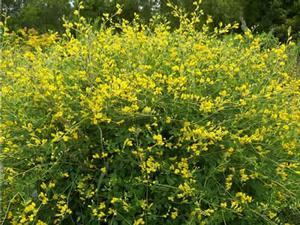New Moon Nurseries
Baptisia tinctoria
Yellow wild indigo
Native to North America
FIRST IMPRESSIONS: Baptisia tinctoria is an upright shrubby perennial with fine textured gray-green leaves. In late spring and summer, plants are adorned with many short clusters of bright or creamy yellow pea-shaped flowers. Plants thrives in harsh conditions and once established are durable and long lived.
HABITAT & HARDINESS: This is perhaps the most widespread Baptisia spp. in the eastern United States. Baptisia tinctoria ranges from Maine to Florida and west to Minnesota.
Plants are indigenous to dry meadows, oak barrens, pine barrens, open woods and fields.
Hardiness rating is from USDA Zones 3-9.
PLANT DESCRIPTION: Baptisia tinctoria is rounded, densely branched and anchored by a sturdy taproot. Foliage is silvery and trifoliate with three leaflets in each leaf.
In late spring, small terminal racemes of yellow flowers form on the perimeter of the plant. The flowers evolve into small inflated purple pods that are unique and attractive landscape features.
Plants grow 2-3’ tall with 2-3’ spread.
CULTURAL & MAINTENANCE NEEDS: Baptisia tinctoria grows best in full sun or light shade in well drained average to dry soil.
Young plants expend a good bit of energy producing deep roots. As a result they tend to get off to a slow start. Around the third year when roots are established, the upper half of the plant begins to flourish.
Tolerates drought, poor soils and controlled burns. Foliage is pest resistant and somewhat unpalatable to deer, rabbits and livestock due to its alkaloid content.
Excess shade or competition from neighboring plants can inhibit growth and cause decline.
LANDSCAPE USES: This is a good choice for a Wildlife Garden, Urban Landscape or Dry Meadow. Plants are also used as Butterfly Nectar Plants, Butterfly Host Plants or as part of a Grouping or Mass Planting. Baptisia tinctoria has Showy Blooms, Attractive Fruit and can be used in Cottage Gardens, Deer Resistant Plantings, Erosion Control, Low Maintenance Plantings and Perennial Borders
COMPANION & UNDERSTUDY PLANTS: Try pairing with Asclepias tuberosa, Echinacea purpurea, Rudbeckia hirta, Solidago speciosa, and Sorghastrum nutans.
Baptisia australis has similar flowers and foliage and can be substituted if needed.
TRIVIA: Compared to the majority of other Baptisias, this diminutive species has shorter height, smaller leaves and flowers, later blooming season and smaller seed pods that often bear only one seed.
Plants host caterpillars of Frosted Elfin, Wild Indigo Duskywing and Orange Sulfur Butterflies as well as the caterpillars of Io moths and skippers.
Cherokee Indians and early settlers prepared a blue dye from Baptisia tinctoria roots. When the exotic but superior true indigo plant became available, it was used instead. The common name false indigo, however, remained attached to Baptisia tinctoria.
Compared to the majority of other Baptisias, this diminutive species has shorter height, smaller leaves and flowers, later blooming season and smaller seed pods that often bear only one seed.
In late fall, the dense entwined stems can dehydrate and break free from the roots forming a “tumbleweed”.
All Baptisia spp. are nitrogen-fixing legumes. They have a symbiotic relationship with the Rhizobium bacteria that allows them to utilize atmospheric nitrogen.
Commonly called Horsefly Weed due to the belief that a plant attached to a horse’s harness would repel horseflies.
Like most other Baptisia spp., fruit is attacked by seed weevils which consume or destroy about 25% of the seed each year.
Height:
2-3 FeetSpread:
2-3 ftSpacing:
3-6 ftUSDA Hardiness Zone:
3-9Bloom Color:
YellowBaptisia tinctoria Characteristics
Attracts Wildlife
- Butterflies
- Pollinators
- Hummingbirds
Attributes
- Interesting Foliage
- East-Coast Native
- Drought Tolerant
- Cut Flower
- Rock Garden
- Naturalizing
Exposure
- Full Sun to Partial Shade
Deer Resistant
- Deer Resistant
Flowering Months
- June
- May
Foliage Color
- Green
Growth Rate
- Slow
Salt Tolerance
- Medium
Season of Interest (Foliage)
- Summer
- Spring
Soil Moisture Preference
- Dry to Moist
